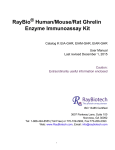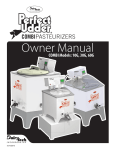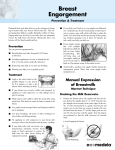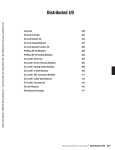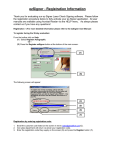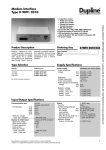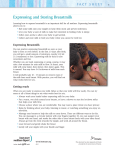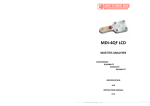Download MKT-7.5.3-L-036 Refractometer Manual for email
Transcript
Refractometer Instruction Manual Two Models Available: CTL-REFM-PRSG: Protein / Specific Gravity CTL-REFM-BR32: BRIX C B A A B C D E D Prism Cover Plate Calibration Screw Tube Focusing Eyepiece E CTL-REFM-PRSG: Protein / Specific Gravity Refractometer Total Protein in serum Range: 0 to 12 g/dl Specific Gravity in urine Range: 1.00 to 1.05 sg Resolution: Resolution: 0.2 g/dl 0.002 sg CTL-REFM-BR32: BRIX Refractometer Brix sugar content Range: 0 to 32 % Resolution: 0.2 % Size: Weight: 30 x 160 mm 215 g Note: Always treat specimen samples as though they were infectious. When using the Refractometer, keep it horizontal as you look into the eyepiece, so that the specimen sample will be less likely to drip out and contaminate the user and/or the surroundings. Clean the refractometer between samples and when done using the instrument according to the guidelines contained within these instructions. This device has a built-in automatic temperature compensation that ranges from 10 degrees C to 30 degrees C (50 to 86 degrees F) Adjusting Focusing Eyepiece Prior to inserting a sample, aim the front of the Refractometer toward a bright indoor light source. Adjust the focusing eyepiece ring (fig. E) until the graduations on the scale can be clearly seen through the eyepiece. Calibration Lift the cover plate (fig. B) and add 1 or 2 drops of distilled water on the surface of the prism (fig. A). Lower the cover plate, making sure that the water covers the entire surface of the prism. View the scale through the eyepiece and, using the enclosed small screwdriver, turn the adjustment screw (fig. C) to make the light/dark boundary coincide (meet) at the “W” at the bottom of the protein scale (Protein / SG model) or at the 0 % mark (BRIX model). Using a soft cotton cloth or absorbent paper, clean and dry the prism before measuring the first specimen. P. 770.270.1394 F. 770.270.2389 865 Marathon Parkway Lawrenceville GA 30046 Operation (Protein / Specific Gravity Model CTL-REFM-PRSG): Lift the cover plate and add 1 or 2 drops of urine or serum (or plasma) depending on which test is desired. Lower the cover plate. Lightly press the cover plate, making sure the liquid is evenly distributed across the prism. You can now read the value of the protein concentration (for serum or plasma) or specific gravity (for urine) from the appropriate scale by reading the boundary line between the light and dark area as it intersects the scale. (BRIX Model CTL-REFM-BR32): Lift the cover plate and add 1 or 2 drops of liquid, such as wine, fruit juice, or other liquids containing sugar. Lower the cover plate. Lightly press the cover plate, making sure the liquid is evenly distributed across the prism. You can now read the percentage of sugar content from the percentage scale by reading the boundary line between the light and dark area as it intersects the scale. •Testing quality of Colostrum for feeding young calves (BRIX Model CTL-REFM-BR32): Follow the operating instructions above for the BRIX refractometer, using 1 or 2 drops of colostrum. Research indicates that BRIX scores of 22% or higher represent good quality in colostrum, 18-21% represent colostrum that can be used for second feedings, and scores below 17% will need to be supplemented. •Testing total solids in milk for feeding older calves (BRIX Model CTL-REFM-BR32): Follow the operating instructions above for the BRIX refractometer, using 1 or 2 drops of milk. The expected content of total solids in normal milk would be 12.5% to 13%. The following equation was developed by Penn State to convert BRIX reading to total solids in milk: TOTAL SOLIDS = (0.9984 x BRIX reading) + 2.077 Therefore, a BRIX reading of 10.4% equals 12.5% total solids, and a reading of 10.9% equals 13% total solids. Maintenance and Cautions As with any precision instrument, care should always be used when handling, cleaning, and storing. Storage in a clean, dry, non-corrosive atmosphere is recommended. Avoid dropping or strong shocks. 1 After use, clean with distilled water only. Rinse and dry the glass and metal parts. Store the Refractometer in its case in a clean, cool, dry, non-corrosive atmosphere. 2 Handle the hinged cover plate carefully, so as not to break the hinge. 3 When calibrating, the distilled water and specimens to be measured should all be the same temperature. If the temperature varies greatly between the two, the calibration should be adjusted once every 30 minutes. 4 Never immerse the Refractometer in water. 5 Use extra caution when cleaning to avoid scratching the prism. 6 When used properly, the LW Scientific Refractometer will give years of reliable performance. Protein / Specific Gravity Scale P. 770.270.1394 BRIX scale F. 770.270.2389 MKT-7.5.3-L-036 | Rev 1 865 Marathon Parkway Lawrenceville GA 30046


